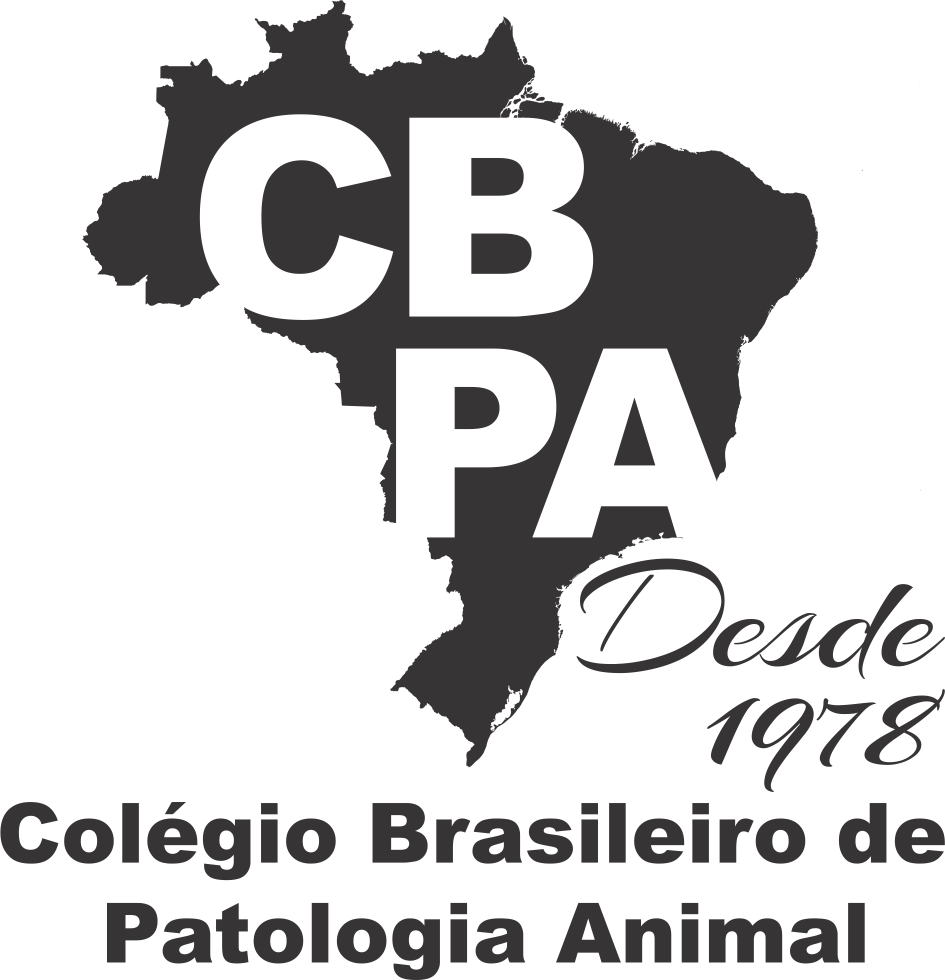Resultado da pesquisa (5)
Termo utilizado na pesquisa cobaias
#1 - Outbreak of leishmaniasis caused by Leishmania enriettii in guinea pigs (Cavia porcellus)
Abstract in English:
We describe an outbreak of leishmaniasis in seven guinea pigs (Cavia porcellus) in which nodular ulcerated skin lesions of varying sizes were observed in the nasal cavity, upper lip, pinnae, vulva, and periarticular region of the limbs. Cytologic exam of collected samples of the lesions in the auricle of one of the animals revealed macrophages containing parasitophorous vacuoles of approximately 4.0μm in diameter in their cytoplasm with morphology suggestive of Leishmania sp. Although skin lesions spontaneously regressed in two of the Guinea pigs, only one survived. All six animals that died were necropsied. Grossly, all animals showed bloody nodular cutaneous lesions with crusts. One of the guinea pigs had distended dark red and firm lungs. Histopathology of the skin lesions revealed histiocytic interstitial acanthotic dermatitis associated with a myriad of Leishmania organisms within macrophages cytoplasm. In the lung, the lesions were characteristic of broncho-interstitial pneumonia with focal infiltrates of neutrophils, epithelioid macrophages, and multinucleated giant cells containing 2µm basophilic amastigotes with morphology compatible with Leishmania spp. A focal granulomatous lesion ,associated with the causal agent in the lung is a novel description of leishmaniasis in guinea pigs caused by L. enriettii. The polymerase chain reaction (PCR) technique with mini-exon primer performed in samples of lesions from two affected guinea pigs was positive and equal to the reference strain, identifying Leishmania enriettii. The cytological, macroscopic, and histological lesions associated with the PCR technique allowed the diagnosis of leishmaniasis and the identification of the specie L. enriettii.
Abstract in Portuguese:
Descrevemos um surto de leishmaniose em sete cobaias (Cavia porcellus), com lesões cutâneas nodulares ulceradas de tamanhos variados observadas na cavidade nasal, lábio superior, pavilhões auriculares, vulva e região periarticular dos membros. No exame citológico foram encontrados macrófagos contendo vacúolos parasitóforos no citoplasma de aproximadamente 4.0μm em diâmetro com morfologia sugestiva de Leishmania sp. Apesar de regressão espontânea das lesões cutâneas terem ocorrido em duas das sete cobaias, apenas um sobreviveu. Seis dos sete animais afetados morreram e foram necropsiados. Macroscopicamente, todos os animais apresentaram lesões cutâneas nodulares, crostosas e sanguinolentas. Uma das cobaias tinha pulmões vermelho-escuros, distendidos e firmes. A histopatologia das lesões cutâneas revelou dermatite acantótica intersticial histiocítica associada a miríades de organismos de Leishmania no citoplasma de macrófagos. Nos pulmões as lesões eram características de pneumonia bronco-intersticial com infiltrado focal de neutrófilos, eosinófilos, macrófagos epitelioides e células gigantes multinucleadas contendo amastigotas basofílicos de 2µm com morfologia compatível com Leishmania spp. Lesões granulomatosas focais associadas ao agente no pulmão são um achado inédito na leishmaniose causada por L. enriettii em cobaias. A técnica de reação em cadeia da polimerase (PCR) com primer mini-exon realizada em amostras de lesões de duas cobaias afetadas foi positiva, identificando Leishmania enriettii. Os aspectos macroscópicos, citológicos, e histológicos associados à técnica da (PCR), permitiram o diagnóstico da leishmaniose e a identificação da espécie L. enriettii.
#2 - Improved method for diagnosis of Nerium oleander poisoning in necropsy tissues
Abstract in English:
Nerium oleander is an ornamental cardiotoxic plant found in tropical and subtropical areas of the World. Its toxicity is related to the content of cardioactive glycosides, mainly oleandrin, found throughout the plant. The present study aimed to describe a new and improved method for oleandrin detection in tissue samples. The determination of oleandrin was made after extraction with a modified QuEChERS technique and measurement by UFLC-MS/MS. A total of 36 guinea pigs (Cavia porcellus) were distributed into 3 groups (n=12): control group that received only water orally (CON), and two treated groups that received hydroalcoholic oleander extract at doses of 150mg.kg-1 (OLE 150) and 300mg.kg-1 (OLE 300) in single oral dose. After three hours, fragments of heart, kidneys, liver and brain were collected for determination of oleandrin levels. The extraction and chromatographic procedures were effective for oleandrin detection and quantification in tissues, with retention time of 1.2 min and detection limit of 0.001µg g-1. The chromatographic analysis of treated guinea pigs indicated that oleandrin is distributed equally among the analyzed tissues. The developed methodology is a reliable, effective and rapid form of diagnosis of N. oleander poisoning based on necropsy tissue samples.
Abstract in Portuguese:
Nerium oleander é uma planta cardiotóxica ornamental encontrada em áreas tropicais e subtropicais do mundo. Sua toxicidade é relacionada á presença de glicosídeos cardioativos, principalmente a oleandrina, encontrada em toda a planta. O presente estudo objetiva descrever um novo e aprimorado método para detecção da oleandrina em amostras de tecido. A determinação da oleandrina foi feita após extração utilizando técnica modificada de QuEChERS e mensuração por UFLC-MS/MS. Um total de 36 cobaios (Cavia porcellus) foi distribuído em três grupos (n=12): grupo controle que recebeu apenas água por via oral (CON), e dois grupos tratados que receberam extrato hidroalcóolico de oleander nas doses de 150mg.kg-1 (OLE 150) e 300mg.kg-1 (OLE 300) em uma única dose oral. Após três horas, fragmentos do coração, rins, fígado e cérebro foram coletados para determinação dos níveis de oleandrina. A extração e procedimentos cromatográficos foram eficientes na detecção e quantificação da oleandrina nos tecidos, com tempo de retenção de 1,2min e limite de detecção de 0,001µg g-1. A análise cromatográfica dos animais tratados indicou que a oleandrina é distribuída de forma equalizada pelos tecidos analisados. A metodologia desenvolvida representa uma forma de diagnóstica segura, efetiva e rápida da intoxicação por N. oleander a partir de amostras de tecidos de necropsia.
#3 - Morphologic and morphometric description of the guinea pigs vesicular gland during postnatal development, 33(7):942-948
Abstract in English:
ABSTRACT.- Gradela A., Nunes A.K.R., Matos M.H.T., Franzo V.S., Faria M.D., Moreira M.B. & Santos J.M. 2013. [Morphologic and morphometric description of the guinea pigs vesicular gland during postnatal development.] Descrição morfológica e morfométrica da glândula vesicular de cobaias durante o desenvolvimento pós-natal. Pesquisa Veterinária Brasileira 33(7):942-948. Colegiado de Medicina Veterinária, Fundação Universidade Federal do Vale do São Francisco, Rodov. 407 Km 12, Lote 543, Projeto Nilo Coelho C1, Petrolina, PE 56300-000, Brazil. E-mail: agradela@hotmail.com
Vesicular glands are essential for reproduction since their secretions affect sperm function. Guinea pigs (Cavia porcellus) are an excellent experimental model for studying vesicular glands, but no morphologic and morphometric data during its development are available. In the present study, the morphology (projections of the folds (PF) and epithelial tissue high (EH) of the mucosa) and the morphometry (mass (GM), volume (GV), length (GC), width of the portions cranial (CRW), medium (MW) and caudal (CAW)) of the vesicular glands were determined at 1, 3, 5, 8, and 11-weeks of age in male guinea pigs (n = 5/age group). In addition, body mass (BM), body length (BL) and height (BH) and organo-somatic index (OSI) were also determined and the simple correlation coefficient (r) was established between the variables. The glands were restricted to the pelvic cavity, and had its interior filled with a semi-solid mass and, after S8, they occupied also the abdominal cavity and the contents were increased significantly. The mucous membrane presented variable folding and simple columnar epithelium. BM, BL and BH increased continuously with age. GM, GV, GC and CAW did not change from 1 to 5-weeks of age, but increased at 8-weeks of age; GM, GV and LCA also increased at 11-weeks of age. OSI and PF increased at 8 and 11-weeks of age and EH at 5, 8 and 11-weeks of age. There was significant (r) between age, body and glandular parameters; OSI and GM at 8 and 11-weeks of age; age and PF, age and EH and between PF and EH. In conclusion, the guinea pigs vesicular glands followed morphology observed in rats and hamsters, but differed in some aspects from others histricomorfs, can be used as experimental model and its morphological and morphometric development can be divided into three phases: 1 to 5-weeks of age, when they are discrete; 6 to 8-weeks of age when they are generally sharp and >8-weeks of age, when there is an intense increase of the secretory capacity.
Abstract in Portuguese:
RESUMO.- Gradela A., Nunes A.K.R., Matos M.H.T., Franzo V.S., Faria M.D., Moreira M.B. & Santos J.M. 2013. [Morphologic and morphometric description of the guinea pigs vesicular gland during postnatal development.] Descrição morfológica e morfométrica da glândula vesicular de cobaias durante o desenvolvimento pós-natal. Pesquisa Veterinária Brasileira 33(7):942-948. Colegiado de Medicina Veterinária, Fundação Universidade Federal do Vale do São Francisco, Rodov. 407 Km 12, Lote 543, Projeto Nilo Coelho C1, Petrolina, PE 56300-000, Brazil. E-mail: agradela@hotmail.com
Glândulas vesiculares são essenciais para a reprodução, pois suas secreções afetam a função espermática. Cobaias (Cavia porcellus) são um excelente modelo experimental para estudo destas glândulas, contudo não existem dados morfológicos e morfométricos durante seu desenvolvimento. Neste estudo a morfologia (projeções das pregas (PP) e altura das células epiteliais (AE) da túnica mucosa) e a morfometria (massa (MG), volume (VG), comprimento (CG), largura das porções cranial (LCR), média (LM) e caudal (LCA)) das glândulas vesiculares foram determinadas em cobaios (N= 25) com uma (S1), três (S3), cinco (S5), oito (S8) e onze (S11) semanas de idade (N=5/grupo de idade). Em adição massa (MC), comprimento (CC) e altura (AC) corporais e o índice organo-somático (IOS) foram também determinados e o coeficiente de correlação (r) estabelecido entre as variáveis. As glândulas restringiam-se a cavidade pélvica e tinham seu interior repleto de uma massa semi-sólida e, após a S8, ocuparam também a cavidade abdominal e tiveram o conteúdo aumentado significativamente. A túnica mucosa era pregueada e forrada de um epitélio simples colunar. MC, CC e AC aumentaram continuamente com a idade. MG, VG, CG e LCA não se alteraram da S1 a S5 e aumentaram na S8; enquanto que MF, VG e LCA também aumentaram na S11. IOS e PP aumentaram na S8 e S11 e AE na S5, S8 e S11. Houve (r) significativo entre a idade, Bc e MFg,; IOS e MG na S8 e S11; idade e PP; idade e AE e entre PP e AE. Em conclusão, as glândulas vesiculares de cobaios seguiram o padrão morfológico observado em ratos e hamsters, mas diferiram em alguns aspectos de outros histricomorfos, podendo ser utilizadas como modelo experimental e seu desenvolvimento morfológico e morfométrico podem ser divididos em três fases: da S1 a S5, quando são discretos; da S6 a S8 de idade, quando são acentuados de maneira geral e após a S8, quando há incremento intenso da capacidade secretória.
#4 - Intoxicação aguda e abortos em cobaias pelas favas de Enterolobium contortisiliquum (Leg. Mimosoideae), p.593-596
Abstract in English:
ABSTRACT.- Bonel-Raposo J., Riet-Correa F., Guim T.N., Schuch I.D., Grecco F.G. & Fernandes C.G. 2007. [Acute poisoning and abortions in guinea pigs by the pods of Enterolobium contortisiliquum (Leg. Mimosoideae).] Intoxicação aguda e abortos em cobaias pelas favas de Enterolobium contortisiliquum (Leg. Mimosoideae). Pesquisa Veterinária Brasileira 28(12):593-596. Departamento de Patologia Animal, Faculdade de Veterinária, Universidade Federal de Pelotas, Campus Universitário s/n, Pelotas, RS 96010-900, Brazil. E-mail: bonel-raposo@brturbo.com.br
The objective was to study the acute toxicity and the abortive properties of Enterolobium contortisiliquum pods in guinea pigs. Pods of E. contortisiliquum were administered orally to 4 groups of 3 guinea pigs each. Another group of 3 guinea-pigs was used as control. Group 1 and 2 were fed with one dose of 5 and 10g of pods for kg body weight, respectively. The guinea pigs of Group 3 and 4 received 10 and 15g/kg, respectively, divided into daily doses of 5g/kg. One guinea pig from Group 2 and one from Group 4 died 12 and 18 hours after the end of the administration. Gross lesions were hemorrhages of the stomach and of the large and small gut, enlarged liver, and dilated gall bladder. Histologically, the liver had severe vacuolation and necrosis of periportal hepatocytes. In another experiment a ration containing 4% of pods of E. contortisiliquum was fed to 2 groups of 4 guinea-pigs, 35 days after mating. Four of the 8 guinea pigs aborted 6-15 days after the beginning of ingestion. The other 4 guinea pigs were not pregnant. All guinea pigs were euthanized after abortion or at the end of the experiment. Histologically all animals had mild to severe periportal hemorrhagic necrosis. All fetuses had variable degree of autolysis. In 4 fetuses studied no significant histologic lesions were observed. The acute lesions observed in guinea-pigs are similar than those observed in the spontaneous poisoning by Enterolobium spp. in cattle. Similar lesions are observed in guinea-pigs poisoned experimentally with saponins from E. gummiferum. The results of the experiments in pregnant guinea pigs suggest that E. contortisiliquum can be used to study the abortive effect of its pods or its toxic compounds.
Abstract in Portuguese:
ABSTRACT.- Bonel-Raposo J., Riet-Correa F., Guim T.N., Schuch I.D., Grecco F.G. & Fernandes C.G. 2007. [Acute poisoning and abortions in guinea pigs by the pods of Enterolobium contortisiliquum (Leg. Mimosoideae).] Intoxicação aguda e abortos em cobaias pelas favas de Enterolobium contortisiliquum (Leg. Mimosoideae). Pesquisa Veterinária Brasileira 28(12):593-596. Departamento de Patologia Animal, Faculdade de Veterinária, Universidade Federal de Pelotas, Campus Universitário s/n, Pelotas, RS 96010-900, Brazil. E-mail: bonel-raposo@brturbo.com.br
The objective was to study the acute toxicity and the abortive properties of Enterolobium contortisiliquum pods in guinea pigs. Pods of E. contortisiliquum were administered orally to 4 groups of 3 guinea pigs each. Another group of 3 guinea-pigs was used as control. Group 1 and 2 were fed with one dose of 5 and 10g of pods for kg body weight, respectively. The guinea pigs of Group 3 and 4 received 10 and 15g/kg, respectively, divided into daily doses of 5g/kg. One guinea pig from Group 2 and one from Group 4 died 12 and 18 hours after the end of the administration. Gross lesions were hemorrhages of the stomach and of the large and small gut, enlarged liver, and dilated gall bladder. Histologically, the liver had severe vacuolation and necrosis of periportal hepatocytes. In another experiment a ration containing 4% of pods of E. contortisiliquum was fed to 2 groups of 4 guinea-pigs, 35 days after mating. Four of the 8 guinea pigs aborted 6-15 days after the beginning of ingestion. The other 4 guinea pigs were not pregnant. All guinea pigs were euthanized after abortion or at the end of the experiment. Histologically all animals had mild to severe periportal hemorrhagic necrosis. All fetuses had variable degree of autolysis. In 4 fetuses studied no significant histologic lesions were observed. The acute lesions observed in guinea-pigs are similar than those observed in the spontaneous poisoning by Enterolobium spp. in cattle. Similar lesions are observed in guinea-pigs poisoned experimentally with saponins from E. gummiferum. The results of the experiments in pregnant guinea pigs suggest that E. contortisiliquum can be used to study the abortive effect of its pods or its toxic compounds.
#5 - Intoxication by Solanum fastigiatum var. fastigiatum: evolution and reversibility of the lesions in cattle and susceptibility of sheep, rabbits, guinea pigs and rats
Abstract in English:
The evolution of lesions caused by Solanum fastigiatum var. fastigiatum in the central nervous system of cattle was studied experimentally in 7 calves. The doses used varied from 75 to 1,163 g/kg of body weight, administered in periods from 15 to 620 days. Initial alterations were characterized by vacuolation of Purkinje cells and the presence of axonal spheroids in the cerebellar granular layer. Later there was a loss of Purkinje cells which were replaced by astroglia. Axonal spheroids suffered wallerian degeneration and, as a consequence microcavitation and proliferation of astroglia were observed. Simultaneously with the degenerative process, perivascular cuffing, consisting mainly of macrophages, was observed. The reversibility of the lesions was studied in four calves, two of which received 440 g/kg of body weight while the other two received 350 g/kg. One of the animals which received 440 g/kg during 140 days and another which received 350 g/kg during 107 days were slaughtered at the end of plant administration. The remaining two animals were maintained without the plant for an additional 113 and 63 days, respectively, and then slaughtered. This study showed that lesions in the pericaryon and axons of Purkinje cells, are slowly reversible, and that some spheroids probably originating from the lost Purkinje cells, suffer wallerian degeneration. The lesions observed, as well as their evolution, are similar to those described in storage diseases. The fact that these alterations are slowly reversible points to the possibility thant the disease occurs as a consequence of an enzymatic inhibition or from the presence of a slowly hydrolyzed substance in the plant. In order to study the susceptibility to the intoxication by Solanum fastigiatum var. fastigiatum, three sheep were fed 430 g/kg of body weight in a period of 202 to 370 days, while six rabbits, six guinea pigs and eight rats received 10% of the plant in a commercial feed during 120 days. Of all species tested, only sheep were susceptible to the intoxication showing lesions similar to those observed in calves.
Abstract in Portuguese:
Foi estudada a evolução das lesões do sistema nervoso central causadas por Solanum fastigiatum var. fastigiatum em 7 bovinos. Utilizaram-se doses que variaram de 75 g/kg de peso a l.163 g/kg de peso administradas num período entre 15 e 620 dias. As alterações iniciais caracterizaram-se por vacuolização das células de Purkinje e presença de esferóides axonais localizados na substância branca cerebelar. Posteriormente, ocorreu o desaparecimento de células de Purkinje, sendo substituídas por astroglia. Os esferóides axonais sofreram degeneração walleriana, observando-se, em conseqüência, microcavitações e proliferação de astroglia. Simultaneamente ao processo degenerativo, observou-se acúmulo perivascular constituído principalmente por macrófagos. A reversibilidade das lesões foi estudada em 4 bovinos, dois dos quais receberam 440 g/kg de peso, os outros dois, 350 g/kg de peso. Um dos bovinos que receberam 440 g/kg de peso durante 140 dias e outro que recebeu 350 g/kg durante 107 dias, foram sacrificados após o final da administração da planta, e os outros dois animais foram mantidos sem a planta por 113 e 63 dias, respectivamente, e, posteriormente, sacrificados. Este estudo demonstrou que as lesões do pericário e axônios são lentamente reversíveis, e alguns esferóides, pertencentes provavelmente às células de Purkinje já desaparecidas, sofrem degeneração walleriana. As lesões observadas, bem como sua evolução são similares às descritas nas doenças do armazenamento; o fato de que essas alterações sejam lentamente reversíveis indica a possibilidade de que a enfermidade ocorra em conseqüência de uma inibição enzimática ou da presença de uma substância lentamente hidrolisável contida na planta. Para o estudo da suscetibilidade à intoxicação por Solanum fastigiatum var. fastigiatum, foram utilizados 3 ovinos que receberam 430 g/kg de peso, num período de 202 a 370 dias, e 6 coelhos, 6 cobaias e 8 ratos, que receberam planta a 10% misturada em ração comercial durante 120 dias. Das espécies utilizadas, somente os ovinos foram sensíveis à intoxicação por esta planta, mostrando lesões similares às observadas em bovinos.








